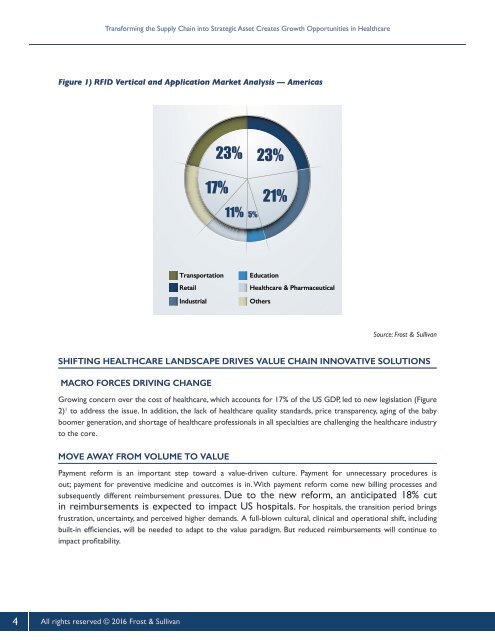FS_WP_CardinalHealth_040816_MC_v3
Create successful ePaper yourself
Turn your PDF publications into a flip-book with our unique Google optimized e-Paper software.
Transforming the Supply Chain into Strategic Asset Creates Growth Opportunities in Healthcare<br />
Figure 1) RFID Vertical and Application Market Analysis — Americas<br />
23%<br />
23%<br />
17%<br />
11% 5%<br />
21%<br />
Transportation<br />
Retail<br />
Industrial<br />
Education<br />
Healthcare & Pharmaceutical<br />
Others<br />
Source: Frost & Sullivan<br />
SHIFTING HEALTHCARE LANDSCAPE DRIVES VALUE CHAIN INNOVATIVE SOLUTIONS<br />
MACRO FORCES DRIVING CHANGE<br />
Growing concern over the cost of healthcare, which accounts for 17% of the US GDP, led to new legislation (Figure<br />
2) 1 to address the issue. In addition, the lack of healthcare quality standards, price transparency, aging of the baby<br />
boomer generation, and shortage of healthcare professionals in all specialties are challenging the healthcare industry<br />
to the core.<br />
MOVE AWAY FROM VOLUME TO VALUE<br />
Payment reform is an important step toward a value-driven culture. Payment for unnecessary procedures is<br />
out; payment for preventive medicine and outcomes is in. With payment reform come new billing processes and<br />
subsequently different reimbursement pressures. Due to the new reform, an anticipated 18% cut<br />
in reimbursements is expected to impact US hospitals. For hospitals, the transition period brings<br />
frustration, uncertainty, and perceived higher demands. A full-blown cultural, clinical and operational shift, including<br />
built-in efficiencies, will be needed to adapt to the value paradigm. But reduced reimbursements will continue to<br />
impact profitability.<br />
4 All rights reserved © 2016 Frost & Sullivan


